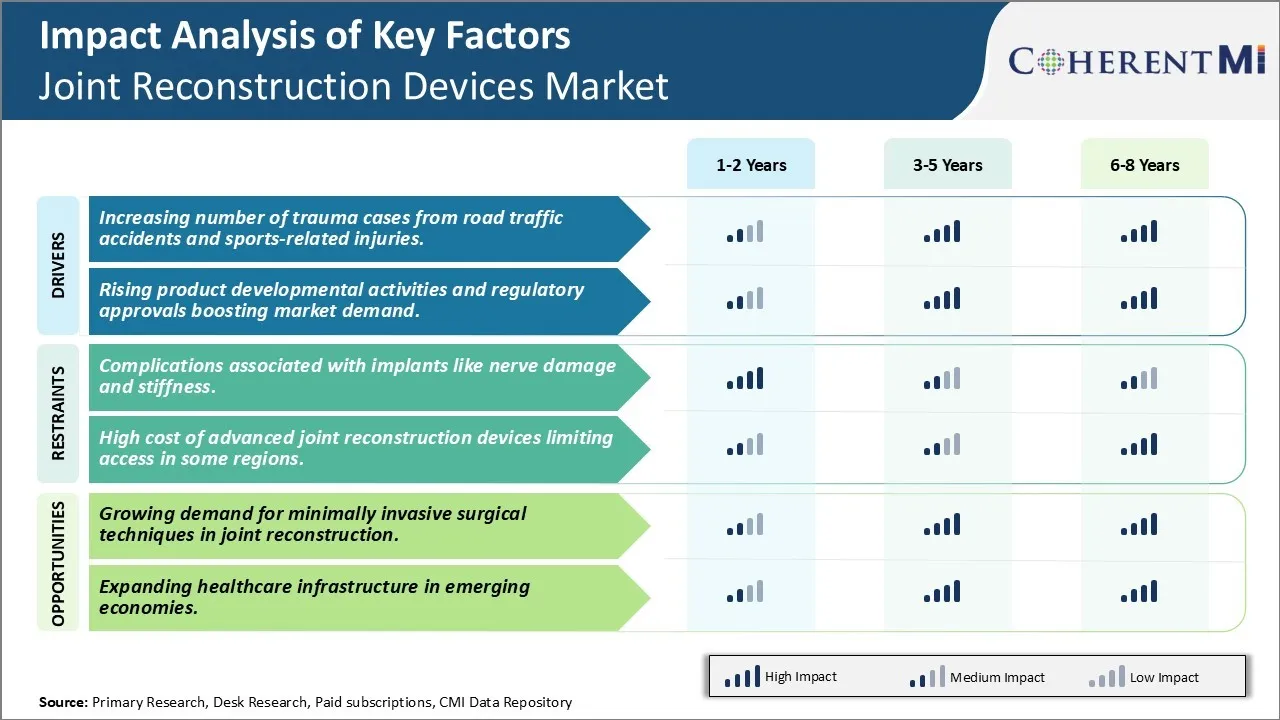Joint Reconstruction Devices Market Trends
Market Driver - Increasing number of trauma cases from road traffic accidents and sports-related injuries
With rising purchasing power and hectic lifestyles, the number of vehicles on road as well as participation in sports activities has increased manifold over the past decade. Unfortunately, this has also led to a sharp rise in the number of trauma cases resulting from road accidents and sports injuries. As per recent estimates by WHO, road accidents account for around 1.35 million deaths globally each year. The agency also states that road traffic injuries are now the leading cause of death for children and young adults between 5–29 years of age.
Apart from lives lost, such accidents often result in severe injuries like fractures and ligament tears that require intensive surgical reconstruction and rehabilitation. Treatment of such complex traumas frequently involves the use of advanced joint reconstruction devices like knee replacement implants, shoulder arthroplasty systems and trauma fixation plates & screws. Additionally, more people are now taking part in contact and adventure sports which pose risks of joint dislocations or fractures. For example, the popularity of games like basketball, football, rugby etc. have increased the number of ligament tears and meniscal injuries that need repair with the help of devices like autografts and allografts.
Market Driver - Rising product developmental activities and regulatory approvals boosting market demand
With the joint reconstruction market demonstrating solid prospects, industry players are ramping up investments in R&D to develop advanced solutions matching the exacting needs of modern surgery. A glimpse of their product pipeline reveals a slew of novel, 3rd generation designs which offer reduction in surgery time, customized sizing options for diverse anatomies, bio-absorbable materials to remove the need for post-op implant removal etc. At the same time, regulatory bodies too have been expediting new product clearances to ensure timely availability of best-in-class treatment choices.
For instance, major companies recently received FDA approval for a new generation of ceramic-on-ceramic total hip replacements offering increased durability and less long-term wear. Similarly, another leading player gained U.S. marketing authorization for an innovative reverse shoulder system engineered to match the complex kinematics of ball-and-socket replacement. Apart from developing totally new solutions, firms are also continually upgrading existing implant designs using advanced technologies like 3D printing, Nano-modification and robotics. This helps enhance performance as well as manufacturability on an industrial scale.

Market Challenge - Complications associated with implants like nerve damage and stiffness
One of the major challenges faced by the joint reconstruction devices market is the complications associated with implants like nerve damage and stiffness. Implantation of devices for joint reconstruction often involves complex surgical procedures that carry risks of damaging nerves in close proximity. This can result in loss of sensation and movement in certain parts of the body. Nerve damage occurs in a small percentage of cases but can significantly impact the quality of life for patients.
Additionally, implants can sometimes lead to stiffness at the joint due to formation of scar tissue. While this issue is more common in traditional open surgeries, even minimally invasive procedures carry some risk of long-term stiffness. The synthetic materials used for implants may not exactly replicate natural joint movement and flexibility over extended periods. Both nerve damage and joint stiffness can require revision surgeries and cause financial burdens for patients. Device manufacturers continue working on newer implant designs and materials that minimize these postoperative complications to make joint reconstruction safer and more effective.
Market Opportunity - Growing demand for minimally invasive surgical techniques in joint reconstruction
One key opportunity for the joint reconstruction devices market is the growing demand for minimally invasive surgical techniques. Traditionally, joint replacement surgeries required making large incisions and extensive soft tissue dissection. This meant longer recovery times for patients, higher risk of complications, and greater costs for healthcare systems. However, newer devices that are compatible with minimally invasive approaches offer advantages like smaller incisions, less pain, shorter hospital stays, and faster return to normal activities. As patients and doctors alike become more aware of these benefits, minimally invasive joint reconstruction is seeing significantly higher uptake compared to traditional open surgeries. Leading manufacturers are actively innovating new implant product lines and surgical tools optimized for minimal access approaches. This shift towards minimally invasive techniques presents substantial market potential for joint device players that can offer comprehensive systems addressing this growing demand.